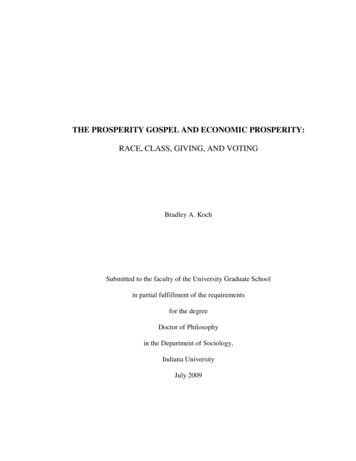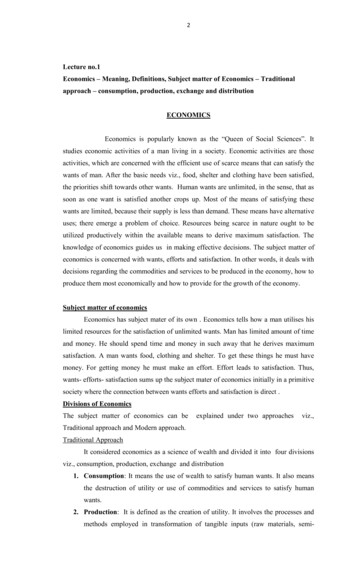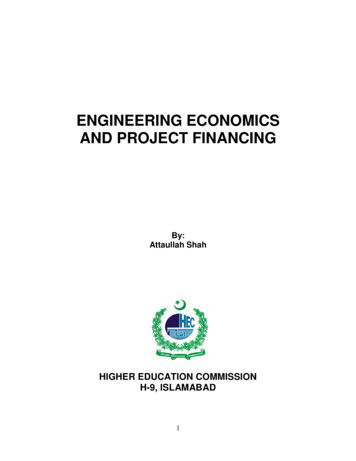
Transcription
RESEARCH BRIEF January 2019ec nfipEconomists for Inclusive ProsperityEconomics for Inclusive Prosperity:An IntroductionSuresh Naidu, Dani Rodrik, and Gabriel Zucman1BackgroundWe live in an age of astonishing inequality. Income andwealth disparities between the rich and the poor inthe United States have risen to heights not seen sincethe gilded age in the early part of the 20th century, andare among the highest in the developed world. Medianwages for American workers remain at 1970s levels.Fewer and fewer among newer generations can expectto do better than their parents. Organizational andtechnological changes and globalization have fueledgreat wealth accumulation among those able to takeadvantage of them, but have left large segments of thepopulation behind. U.S. life expectancy has declinedfor the third year in a row in 2017, and the allocation ofhealthcare looks both inefficient and unfair. Advances inautomation and digitization threaten even greater labormarket disruptions in the years ahead. Climate changefueled disasters increasingly disrupt everyday life.Greater prosperity and inclusion both seem attainable,yet the joint target recedes ever further.This is a time when we need new ideas for policy. Wethink economists, among other social scientists, havea responsibility to be part of the solution, and thatmainstream economics – the kind of economics thatis practiced in the leading academic centers of thecountry – is indispensable for generating useful policyideas. Much of this work is already being done. In ourdaily grind as professional economists, we see a lot ofpolicy ideas being discussed in seminar rooms, policyforums, and social media. There is considerable fermentin economics that is often not visible to outsiders. Atthe same time, the sociology of the profession – careerincentives, norms, socialization patterns – oftenmitigates against adequate engagement with the worldof policy, especially on the part of younger academiceconomists.We believe the tools of mainstream economists not onlylend themselves to, but are critical to the developmentof a policy framework for what we call “inclusiveprosperity.” While prosperity is the traditional concernof economists, the “inclusive” modifier demands boththat we consider the whole distribution of outcomes,not simply the average, and that we consider prosperitybroadly, including non-pecuniary sources of well-being,from health to climate change to political rights. Thepolicy briefs that accompany this overview offer arange of policy recommendations, drawn from laboreconomics, public economics, international economics,financial economics, etc.2 Importantly, we hope thiscollective effort amounts to more than a discussionof specific policy prescriptions in different domainsof economics. Our claim is that there are overarchingthemes and commonalities that taken together providea coherent overall vision for economic policy that standsas a genuine alternative to the market fundamentalismthat is too often (and in our view, wrongly) associatedwith mainstream economics. We strive for a whole thatis greater than the sum of the parts.We shall discuss these broader themes and theconnecting narratives that emerges later in this essay.We begin by discussing in greater detail the motivationbehind the project and the role that we see economicsin crafting an alternative to the status quo.Economists for Inclusive Prosperity Economics for Inclusive Prosperity: An Introductioneconfip.org
Why we are doing thisThe idea for this initiative developed following aworkshop that the three of us attended during thefirst half of 2018. It was one of those multi-disciplinarymeetings that have become increasingly commonrecently, on “new thinking beyond neoliberalism” andsimilar themes. The organizers had brought togetherhistorians, political scientists, sociologists, and legalscholars alongside economists. As is usual in suchmeetings, participants agreed that the prevailing policyframework had failed society, resulting in monumentaland growing gaps in income and wealth. All of us werehorrified by the illiberal, nativist turn our politicshad taken, fueled in part by these chasms. Therewas consensus that we needed to develop a genuinealternative – a set of policies that were both effectiveand inclusive, responding to legitimate grievanceswithout sowing deeper societal divisions.Any economist who sits in such a meeting will eventuallyfind himself or herself on the defensive. For in the eyesof many, the turn towards neoliberalism is closelyassociated with economic ideas.3 Leading economistssuch as Friedrich Hayek and Milton Friedman wereamong the founders of the Mont Pelerin Society, theinfluential group of intellectuals whose advocacy ofmarkets and hostility to government intervention provedhighly effective in reshaping the policy landscape after1980. Deregulation, financialization, dismantling of thewelfare state, de-institutionalization of labor markets,reduction in corporate and progressive taxation,and the pursuit of hyper-globalization – the culpritsbehind rising inequalities – all seem to be rooted inconventional economic doctrines. The discipline’sfocus on markets and incentives, methodologicalindividualism, mathematical formalism, and passionfor causal identification all seem to point towards thestatus quo and stand in the way of meaningful economicand social reform. In short, neoliberalism appears to bejust another name for mainstream economics.Consequently many non-economists view the disciplineof economics if not with outright hostility, at least as partof the problem. They believe the teaching and practiceof economics has to be fundamentally reformed for thediscipline to become a constructive force.And there are, indeed, legitimate reasons for thediscontent with economics, the way it is too oftenpracticed and taught. Conservative foundations andthink tanks have monopolized the banner of economicsin policy circles, pushing the view that there is asteep efficiency-equality trade-off, and normativelyprioritizing economic growth. Students who do notpursue further training leave undergraduate coursesthinking that economics means that “markets alwayswork”. Conservatives tend to deploy “economics” asa justification for preferred policies, while liberals areseen to be insensitive to the requirements for prosperity.But our own take goes beyond this common viewand is substantially different from it. Many of thedominant policy ideas of the last few decades aresupported neither by sound economics nor by goodevidence. Neoliberalism – or market fundamentalism,market fetishism, etc. — is a perversion of mainstreameconomics, rather than an application thereof. Andcontemporary economics research is rife with newideas for creating a more inclusive society. But it is upto us economists to convince their audience about themerits of these claims. That is why we have embarkedon this project. The initial set of policy briefs thataccompany this introduction is our first step. We hopethey will stimulate and accelerate academic economists’sustained engagement with creative ideas for inclusiveprosperity.4Economics is an ally of inclusiveprosperityHow do we square non-economists’ perception withour claim that economics is part of the solution?Economists study markets (among other things) andthey naturally feel a certain pride in explaining theway they operate to those who lack their specializedknowledge. When markets work well, they do a goodjob of aggregating information and allocating scarceresources. The principle of comparative advantage,which lies behind the case for free trade, is one of theprofession’s crown jewels – both because it explainsimportant aspects of the international economy andbecause it is, on the face of it, so counter-intuitive.Similarly, economists believe in the power of incentives,because they have evidence people respond to incentivesand they have seen too many well-meaning programsfail on account of not having paid adequate attentionto the creative ways in which people behave to realizetheir own goals.Economists for Inclusive Prosperity Economics for Inclusive Prosperity: An Introduction2
At the same time, contemporary economics is hardly apaean to markets and selfishness. The typical course inmicroeconomics spends more time on market failuresand how to fix them than on the magic of competitivemarkets. The typical macroeconomics course focuses onhow governments can solve problems of unemployment,inflation, and instability rather than on the “classical”model where the economy is self-adjusting. Thetypical finance course revolves around financialcrises, excessive risk-taking, and other malfunctionsof financial systems. In fact, the standard competitiveequilibrium model in which free markets are maximallyefficient (even if still not necessarily socially optimal,in view of distributional concerns) is the dominantframework only in introductory economics courses.Serious students of economics quickly move away from it.Economics remains somewhat insular within socialsciences because of its methodological predilections:methodological individualism, model-based abstraction,mathematical and statistical formalism. But in recentdecades economists have reached out to other disciplinesand have incorporated many of their insights. Economichistory is experiencing a revival, behavioral economicshas put homo economicus on the defensive, and thestudy of culture has become mainstream. Distributionalconsiderations are making a comeback at the center ofthe discipline. Economists have been at the forefront ofstudying the growing concentration of wealth, the costsof climate change, concentration of important markets,the stagnation of income for the working class, and thechanging patterns in social mobility.Economists often have a bias towards market-basedpolicy solutions, sustained by a demand for identifyingprecise market failures as a precondition for policyinterventions. But the science of economics has neverproduced pre-determined policy conclusions. In fact,all predictions and conclusions in economics arecontingent: if these and these conditions hold, thenthese outcomes follow. The answer to almost anyquestion in economics is “it depends,” followed by anexegesis on what it depends on and why.5 Back in 1975, ina collected volume titled International Trade and Finance:Frontiers for Research an economist wrote: “by now anybright graduate student, by choosing his assumptions. carefully, can produce a consistent model yieldingjust about any policy recommendation he favored at thestart” (Diaz Alejandro, 1975). Economics has becomeeven richer in the intervening four decades. We mightsay, only slightly facetiously, that today the graduatestudent need not even be that bright!Moreover, economics research has become significantlymore applied and empirical since the 1990s. The shareof academic publications that use data and carry outempirical analysis has increased substantially in allsub-fields within economics, and currently exceeds 60percent in labor economics, development economics,international economics, public finance, andmacroeconomics (Angrist et al., 2017). This is importantbecause systematic empirical evidence is a discipliningdevice against ideological policy prescriptionsembedded in preconceived theorizing. The empiricalbent of economics makes it more difficult to ignoreinconvenient facts, when real world markets do notbehave like textbook ones. It is harder to idolize marketswhen research finds international trade produces largeadverse effects on some local communities, minimumwages do not reduce employment, or financialliberalization produces crises rather than fastereconomic growth – just to point out a few empiricalfindings from the recent economic literature.Economics does have its universals, a set of higherorder principles associated with efficiency and generallypresumed to be conducive to superior economicperformance: market-based incentives, clear propertyrights, contract enforcement, macroeconomic stability,prudential regulation, and so on. But these principlesare compatible with an almost infinite variety ofinstitutional arrangements. Each of these institutionalarrangements – rules of the game — produces a differentdistributional outcome. And how it contributes tooverall prosperity depends on the suitability to thespecific context at hand. This is a recipe for comparativeinstitutional analysis of economic performance, andno glib “markets work” slogans follow from it. Theabstraction with which economists perceive complexbundles of institutions also gives practitioners toolsto help design large scale alternatives; from precisiontweaks to the tax code to full-blown visions of postcapitalist societies.Consider the simplest economic setting of a perfectlycompetitive market economy. When an economistdraws a supply-and-demand diagram on the black board,she may not list all the institutional prerequisites thatlie behind the two curves. Firms have property rightsover their assets and can enforce their contracts withsuppliers. They have access to credit, can rely on publicinfrastructure such as transportation and power, andEconomists for Inclusive Prosperity Economics for Inclusive Prosperity: An Introduction3
are protected from thieves and bandits. Their employeesaccept the terms of employment and show up at workeach day. Consumers have all the information theyneed to make reasonable choices. They are reasonablyconfident that firms do not cheat them. There is a stableunit of value and means of exchange for buying andselling goods.Clearly markets rely on a wide range of institutions; theyare “embedded” in institutions, as Karl Polanyi wouldsay. But how should those institutions be designed?Take property rights, for example. The Coase theoremsuggests it does not matter for efficiency how propertyrights are allocated as long as transaction costs are zero.But the caveat does a lot of work here, even if we focusonly on efficiency: clearly transactions costs mattergreatly. So we must make choices. Should a job belongto a company, a worker, or a combination? Perhaps thecompany itself should be owned by a third party -- a localgovernment entity, say -- and simply ensure incentivecompatibility for managers and workers. You mightthink this is crazy, but China has eked unprecedentedrates of economic growth out of such a property-rightsregime. We can think of many other variants. Perhapsemployers should have property rights (for a fixedperiod) only over new assets they create, with existingassets distributed among other claimants. That toosounds crazy, unless we realize that is exactly whatthe patent system does, giving innovators temporaryownership over new “intellectual property.” Perhapsgovernment should retain part ownership of newtechnologies, on behalf of the general public, sinceso much of innovation relies on public infrastructure(public R&D and subsidies, higher education, thelegal regime, etc.). Distributional concerns add to thechoices that need to be made. Which among these (andother) possibilities we should favor depends both onour ultimate objectives and the potential fit with localcontext.As we grapple with new realities created by digitization,demographics, and their impacts on labor markets, suchquestions about the allocation of property rights amongdifferent claimants become crucial. Economics doesnot necessarily have definite answers here. Nor doesit provide the appropriate distributional weights (howdo weight the returns to workers, employers, and thegovernment, and what procedural and deontologicalconstraints should be respected). But it supplies thetools needed to lay out the tradeoffs, thus contributingto a more informed democratic debate.The same kind of institutional indeterminacy pervadesall other policy domains. Which labor market institutionsminimize job insecurity without jeopardizingemployment creation? How do we best provide socialprotection without blunting economic incentives? Whatkind of financial regulations ensure financial stabilitywithout blocking financial innovation? What kind ofmonetary and fiscal rules are best for an open economy?Once again, economics does not provide a fixed answerto these questions. Instead, it highlights the potentialconsequences of different arrangements.Economists have a powerful theoretical machinerythat allows them to think in abstract terms aboutsuch matters. So they are well positioned to developinnovative institutional arrangements that go beyondthe already considerable variety that exists in the worldtoday. Welfare or labor-markets arrangements, say,differ greatly across the developed world. There is muchthat the U.S. can learn from experiments elsewhere. Butplausible institutional diversity is not limited to existingpractices. We can – and will need to – to develop newinstitutions. Nothing in free markets guarantees thatgrowth will be equitable or globalization sustainable.There’s always a need to design policies and institutionsto make inclusive prosperity possible and globalizationsustainable politically and economically. Economists’imagination is crucial to the task.Economists’ habits are to blametooThe misunderstanding of what economics is (andwhat economists do) is compounded by the wayeconomists frequently engage in public debates. Toomany economists believe their quantitative toolsand theoretical lenses are the only ones that count as“scientific,” leading them to dismiss disciplines that relymore on qualitative analysis and verbal theorizing. Manyeconomists feel they need to take the side of markets,because no-one else will do so and because doingotherwise might “provide ammunition to barbarians.”And even when they recognize market failures, theyworry government action will make things worse. As aresult, many of the discipline’s caveats are swept underthe rug. And economists get labeled as cheerleaders forfree markets and hyper-globalization.There is often a naïve political economy at play here,Economists for Inclusive Prosperity Economics for Inclusive Prosperity: An Introduction4
with the implicit assumption that self-interestedpressure groups and rent-seekers – the so-calledbarbarians -- are represented only on one side of a policyquestion.6 In reality, every market equilibrium, withor without public action, creates winners and losers.These groups necessarily try to bend outcomes to theirliking. Neoliberalism certainly has had its own powerfullobbies. Free-market oriented policies since the 1980shave been hijacked by their own special interests, aswe can see in corporate taxation or trade agreementsfor example. Good policy cannot be abstracted frompolitics and has to be designed by taking its likely effectsinto account. This is as true for policies that purportedlytry to take the government out of the market as it is forpolicies that broaden the government’s role.Economists often get too enamored of first-bestbenchmarks within a model tailored to study a narrowset of issues. This leads them to focus on the directefficiency consequences in the area under focus, atthe expense of potential complications and adverseimplications elsewhere. A growth economist will analyzepolicies that enhance technology and innovation withoutworrying about labor market consequences. A tradeeconomist will recommend reducing tariffs, and assumethat devising compensatory mechanisms for the losersis somebody else’s job. A finance economist will designregulations to make banks safe, without considering howthese may interact with macroeconomic cycles. Manypolicy failures – the excesses of deregulation, hyperglobalization, tax cuts, fiscal austerity – can be tracedto such first-best reasoning. To be useful, economistshave to evaluate policies in the totality of the contextin which they will be implemented, and consider therobustness of policies to many possible institutionalconfigurations and political contingencies. As AvinashDixit (2009) puts it, “the world is second-best at best.”Some common themes in thepolicy essaysAll of the participants in this project are academiceconomists, working in broadly mainstream subfields.Some have worked in government; most have not. Somehave engaged in writing broadly for a non-academicaudience; most have not. They are researchers whobelieve sound scholarship is indispensable to show theway to inclusive prosperity. They are all economistsof the real world, who understand that we live in asecond-best world rife with market imperfections, andin which power matters enormously in shaping marketoutcomes.In such a world the competitive model is rarely theright benchmark for understanding the problemsand suggesting solutions. We must instead searchfor alternative models. This requires an empiricalorientation, an experimental mind set, and a good doseof humility – to recognize the limits of our knowledge.The policy proposals in these essays reflect economicreasoning and contemporary evidence on a variety ofmarket failures, from international trade to insurance tocapital and labor markets. Shot through the proposals isthe sense that economies are operating well inside thejustice-efficiency frontier, and that there are numerouspolicy “free-lunches” that could push us towards aneconomy that accords with our moral intuitions withoutsacrificing (and indeed possibly enhancing) prosperity.Taking contemporary economics seriously is consistentwith recommending fairly dramatic structural changesin American economic life.Many of the proposals involve efficiency-and-equalityenhancing interventions in markets well known tobe rife with market failure, such as labor markets(Dube and Naidu), credit markets (Admati and Mian),insurance markets (Black and Rothstein), and marketsfor innovation (Korinek). While the theoretical basisfor market failures in these domains has been apparentfor some time, the empirical importance of the variousfailures has been made only recently.For example, while the minimum wage debate continues,there is a consensus that it is not an effective tool forintervening in labor markets with wages higher thansay, the 30th percentile. Other labor market institutionsare needed to take advantage of free lunches createdby monopsony and other labor market failures in thesegment of the labor market where most workersfind themselves. Dube proposes a system of wageboards, similar to the Australian system, where eitheradministrators or tripartite boards negotiate wagesat the industry-occupation-region level, thus settingminimum wages throughout the distribution. He findsthat wage inequality would significantly fall as a result.Naidu discusses the more traditional American labormovement, and possibilities for economics to helporganized labor overcome some of the limitations ofthe current U.S. industrial relations institutions.Economists for Inclusive Prosperity Economics for Inclusive Prosperity: An Introduction5
In the domain of capital markets, both Admati and Mianstress the systemic risk produced by the current system.Mian discusses the role that inequality, together withcapital flows from oil-rich countries and Asia, hasplayed in generating a “glut” of savings, pushing downthe real interest rate and increasing systemic risk.Admati looks at the banking sector, showing how banks,uniquely among financial institutions, are overexposedto debt, making them more vulnerable to bankruptcyand again, a threat to stability. Both authors point toa variety of macroprudential regulatory options, withMian emphasizing credit contract repayments that arecontingent on the aggregate state of the economy, andAdmati favoring capital requirements and tax reformsthat make debt look less attractive.Two of the proposals speak directly to how the sizefor government can be increased in a sustainable andprosperity-enhancing way. Zucman’s proposal showsan ingeniously simple path out of international taxcompetition, where countries no longer have to bid formultinational investment by slashing corporate taxes.Zucman proposes taxing multinationals by allocatingtheir global profits proportionally to where they maketheir sales. While companies can easily relocate profitsor production to low-tax jurisdictions today, sales aremuch harder to manipulate. His reform would thus makeit possible to tax the very winners of globalization—probably a necessary condition for globalization to besustainable in the long run.Black and Rothstein provide a contemporary restatementof an old idea: government should provide public goodsand social insurance, and root this argument in the bestmodern economics. For example, education requiresgovernment provision because parents cannot borrowagainst the earnings of their children (and childrenhappen generally before the peak income of the parents).The benefits of education are also in the far future, andare associated with externalities in crime, citizenship,and innovation. All this militates in favor of governmentprovision of education. Social insurance mitigatesthe widespread and well-known failures in insurancemarkets, in the form of unemployment insurance, socialsecurity, and health insurance.Korinek takes up the increasingly important questionof how new technologies affect labor markets and thedistribution of income. The direction of technologicalchange is not exogenous, he argues, and it depends onthe incentives set both by markets and by governments.In particular, innovators may over-estimate the socialcost of labor, investing too much in technologies thatreplace labor. Governments routinely intervene in theprocess of innovation, for example to encourage greentechnologies. Korinek proposes that they similarly steertechnology in the direction of innovations that havedesirable distributive properties. Promoting AI systemsthat complement and augment the cognitive abilities ofworkers – along with mechanisms that ensure workersretain substantial part of the surplus generated – wouldbe an example. Korinek also discusses how inelastic,complementary factors such as land or specialized skillsmight be taxed in response to technological change,and how the value of monopolies granted by the patentsystem is intrinsically inegalitarian, as it transfersincome from consumers to owners of firms.Another way to look at a slice of the proposals is viaKarl Polanyi: to work well, crucial markets (e.g. the“fictitious commodities” of labor, land, and capital)must be embedded in non-market institutions, the“rules of the game” supplied by government. Rodrik, forexample, shows that trade agreements ought to includeclauses that prevent competition on “unjust” margins;and Dube shows that wage boards setting marketspecific minima could compress wages a lot, with muchmore refined targeting than a blunt, economy-wideminimum wage. Mian shows how inequality generatesinstability in financial markets, but also how privatemacro-prudential contracting is thwarted both becausethere is an aggregate externality as well as specific taxand regulatory structures (e.g. Basel III risk weighting).Rodrik’s proposal is distinctive in that if gives anexplicitly pro-social justification for restrictions ontrade, not trying to clothe the protectionism in terms ofameliorating some other externality or market failure.Rodrik’s “social safeguards” would give countriesa claim, justified by broad social support, on tradeauthorities that a restriction on trade is necessary tomaintain the domestic social contract. This proposal isindicative of the commitments of many of the membersof EFIP; a willingness to subordinate textbook economicefficiency to other values such as democratic rule andegalitarian relationships among citizens.Finally, some of the proposals propose fixing non-marketinstitutions with ideas from economics. Importantlyfor any policy proposals in 2018, democratic politicaleconomy must be considered, where people’s influenceon policy is roughly equal and political preferences arearrived at through open, well-informed public debate.Economists for Inclusive Prosperity Economics for Inclusive Prosperity: An Introduction6
Too many policy ideas break on the rock of governmentcapture by special interests or systematically distortedpresentations in the media. Ethan Kaplan’s proposaldraws on a few decades of empirical political economy tosuggest policies that could drastically alter the balanceof political influence in the United States. SureshNaidu’s proposal hints at ways mechanism design andbehavioral economics can be mobilized to ease thepervasive collective action problem facing unions.Ethan Kaplan’s proposal exemplifies the strengthsof empirical political economy, as practiced ineconomics departments. The evidence cited is allcarefully identified from naturally occurring variation,and suggests a number of policies that could equalizepolitical representation and increase turnout. Some ofthese suggestions highlight margins that are more likelyto be thought of by an economist rather than a politicalscientist: for example the increased influence of moneywhen media coverage of politics is low, suggestingthat politicians, behaving somewhat rationally, tradeoff responsiveness across pecuniary and popularconstituencies.A theme running through many of the essays is thepower asymmetries that shape the functioning of ourcontemporary economy. Many economists dismissthe role of power because, as Naidu puts it in hisessay, “under conditions of perfect competition andinformation, there is no scope for power.” Talk aboutpower is viewed as non-rigorous, or at least as belongingoutside economics. But asymmetries between differentgroups abound: who has the upper hand in bargainingfor wages and employment; who has market power andwho gets to compete; who can move across borders andwho is stuck at home; who can evade taxation and whocannot; who gets to set the agenda of trade agreementsand who is excluded; who can vote and who iseffectively disenfranchised. Some of
economics, public economics, international economics, financial economics, etc.2 Importantly, we hope this collective effort amounts to more than a discussion of specific policy prescriptions in different domains of economics. Our claim is that there are overarching themes and commonalities that taken together provide










